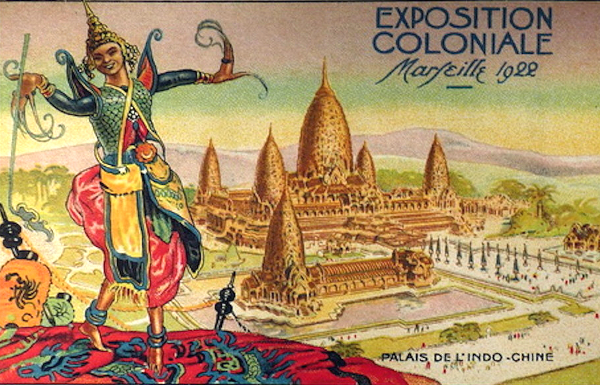
MARSEILLES, FRANCE 1922
Colonial Exposition
Sponsor this page for $75 per year. Your banner or text ad can fill the space above.
Click here to Sponsor the page and how to reserve your ad.
Quick List Info

Dates Open - April 16 to November 19, 1922.
Attendance - Around 3 million.
International Participants - 1 nation, France, plus 24 French colonies.
Total Cost - Cost 6 million francs. Cost quoted seems low for total expenses, however, most pavilions were paid for by exhibitors, thus Expo Authority costs may have been lower than normal for an exposition of this scale.
Site Acreage - 36 hectares (89 acres).
Sanction and Type - Prior to the Bureau of International
Exhibitions. Colonial exposition of French possessions would not qualify at that time, even if sanctioning had begun. However, colonies are now essentially countries, therefore it was international in scope.
Ticket Cost - Unknown.
Photo top center: Postcard from the 1922 Marseilles Colonial Exhibition showing the Palace of Indo-China, 1922, Original source unknown. Column Top: Poster from the Marseilles Colonial, 1922, Capiello. Courtesy Postercornner.com. Column Bottom: Postcard of the Pavilion of Equatorial Africa, 1922. Courtesy Wikipedia Commons.
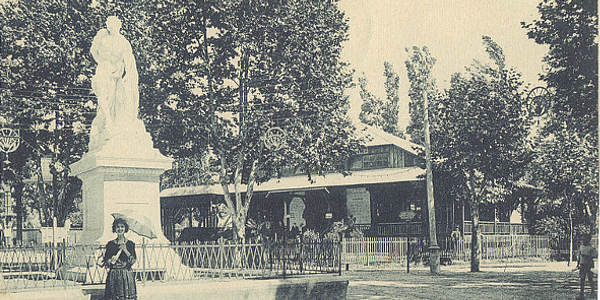
Other Histories of World's Fairs to Check Out
-
Quick List of All Expos
1st World's Fair in History
London 1851
Other Paris Fairs
Paris 1855
Paris 1867
Paris 1878
Paris 1889
Paris 1900
Paris 1925
Paris 1931
Paris 1937
- For more info about the World's Fair Decision Model, development of the model, the study participants, etc. The development is currently being utilized for in-house publishing projects, but is not available for work-for-hire decuments or consulting.
- For More info about the Bureau of International Exhibitions - Sanctioning body for international exposition (world's fairs) headquartered in Paris, France.
- For more info about previous EXPOcheck reports.
History of the Event
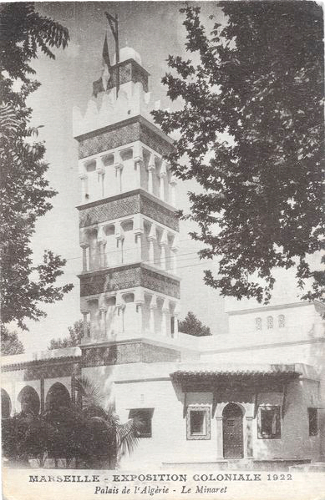
Perhaps we should not quibble with the colonial designation as not being a true world's fair. Alas, those colonial possessions of France are now nations, and although they were not that designation per 1922, that still makes them international. But, let's not quibble. The representation of French colonial possessions at the Colonial Exhibition of 1922 was significant, and the fair, the second colonial exhibition for Marseilles after a smaller event in 1906, was bold in its architecture and significant in promoting the value of the colonies to the French citizens of the time. There had been a power struggle between Marseilles and Paris after the 1906 fair on who should next host a colonial exposition. It was agreed that both would host, eventually, postponed by World War I to Marseilles in 1922 and Paris in 1931.
It would be held in Round de Point Park, site of the 1906 fair, and since that date, host to French and colonial troops during World War I in legacy buildings the Grand Palace and Palace of Machines. Upon inauguration on April 16, 1922, the site, now replete with architectural representations from Angkor Wat to Africa from those possessions on less than one hundred acres, would hold Congresses, colonial days, and exhibits from all over the French controlled world. The Mayor of Marseilles, Simeon Flaissieres, and Commissioner General of the Exhibition, Adrien Artaud, were among the dignitaries to inaugurate the event on Opening Day.
Beyond the pavilions of the colonies, which were the stars of this show, there were exhibits by the Chamber of Commerce of Marseilles, the Levant, a Fine Arts Section, an Agricultural and Horticultural Section, as well as a Palace of Navigation. Palace of Machines, Pavilion devoted to Aerospace. and a Pavilion of Tourism.
Above photo. Palace of Algeria, 1922. Courtesy Pinterest. Below: Postcard of the Indochina pavilion, 1922, Original source unknown. Courtesy Marseilles Tourism.
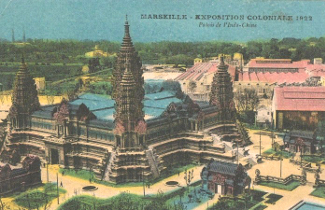
Depending on your point of view, the exhibition accomplished what it set out to do. For the organizers, they exhibited the value of colonialism, as well as the natives who lived there. For the colonials themselves, they showed their cultures to a European population who had no real connection to the possessions of their nation, but through what most termed a successful exhibition, educated and entertained. There was thought, since 1906, that an exhibit to show the technological progress of the colonies every ten years was a good idea. Marseilles, perhaps in stereotypical fashion, proved that, again, depending on your point of view. Paris would host a colonial exhibition again in nine years in an attempt to keep that mission going for as long as possible. After World War II, however, those possibilities dwindled.
Quote from the post Marseilles Exhibition book by the Commissioner General's Office
"And Algeria! The graciousness of his palace, an elegance which redeems the smallness of the covered surface, is it not a detail to be grasped? Our neighbor was in the middle of a crisis when an exhibition was being prepared. The care of her own greatness and the imperious necessities she had to face at that time met all her attention. This is a point of history, that. Tunisia, neighbor, is quite different; trees play in their role the design of the monument which, behind its walls, houses souks, antiquities, mosques ... When will we meet full saucers of precious stones, shimmering and sparkling, as in the palace of Madagascar? The name in Galliem will disappear from the place it occupies, it must be remembered in this album."

Colonial Exposition
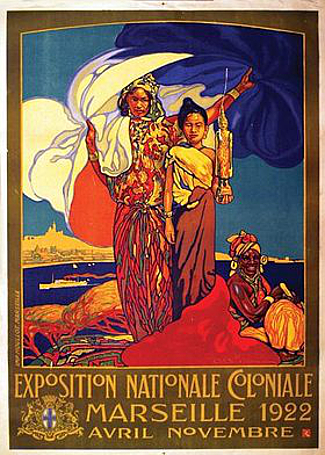
International Participants
Nations and Colonies
Nations - France.
Colonies - Algeria, Tunisia, Morocco, Indo-China (Cochinchina, Annam, Cambolia, Laos, Tonkin), French West Africa, French Equatorial Africa, Madagascar, Cameroon, Martinique, Guadeloupe, New Caledonia, French Guiana, New Hebrides, French Establishments of Oceania, French Indies, French Somalia,
Saint Pierre and Miquelon, the Meeting, Orgeval.
Expo Tidbits
Angkor Palace building hosted the exhibits of the colonies of Indo-China, including Cochinchina, Annam, Tonkin, Cambodia, and Laos. In the 1906 Marseilles Colonial Exhibition, each of those colonies had a separate pavilion.
Due to the occupation of troops in the park during World War I, it became necessary to replace a number of burned or cut trees and partly to rebuild the buildings that had been used for housing the troops prior to holding the 1922 fair.
At the time of the fair, the colonial possessions of France totaled fifty million people on ten million square kilometers of land.
Legacies
The site of the exhibition, Exhibition Park or Rond-Point du Prado, now known as Parc Chanot, still exists with the entrance gates to the exhibition original. The park now includes the Marseilles Convention Center with six additional exhibit halls, Phocean Palace, Grand Palais, Palace of the Mediterranean, Palais des Events, Palace of Europe, and the
Palais des Arts (original building used at the 1922 Colonial).
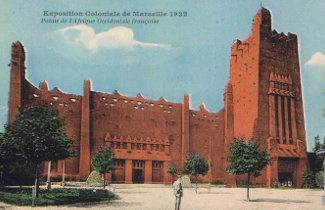
Those in Charge
Mr. Albert Sarraut, Minister of the Colonies. Mr. Adrien Artaud, Deputy, Honorary President of the Marseille Chamber of Commerce, General Commissioner of the National Colonial Exhibition of Marseille in 1922.
Sources: London Times; The Exposition National Colonial from Marseilles 1922 by Charles Regismanset and Rene-Claude Martin, 1921; 1922 Colonial National Exhibition Marseille described by his Authors, Marseille Commissariat General of the Exhibition; Fair News; World of Fairs; Marseilles Board of Tourism; Wikipedia Commons.
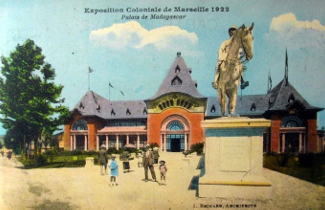
Photo column top: Poster from Marseilles 1922, 1922, David Dellepiane. Courtesy Wikipedia Commons. Middle: Postcard of the Palace of French West Afria, 1922, Original source unknown. Courtesy Marseilles Tourism. Bottom: Postcard of the Palace of Madagascar, 1922, Original source unknown. Courtesy Marseilles Tourism.
Colonies - Algeria, Tunisia, Morocco, Indo-China (Cochinchina, Annam, Cambolia, Laos, Tonkin), French West Africa, French Equatorial Africa, Madagascar, Cameroon, Martinique, Guadeloupe, New Caledonia, French Guiana, New Hebrides, French Establishments of Oceania, French Indies, French Somalia, Saint Pierre and Miquelon, the Meeting, Orgeval.
Expo Tidbits
Angkor Palace building hosted the exhibits of the colonies of Indo-China, including Cochinchina, Annam, Tonkin, Cambodia, and Laos. In the 1906 Marseilles Colonial Exhibition, each of those colonies had a separate pavilion.
Due to the occupation of troops in the park during World War I, it became necessary to replace a number of burned or cut trees and partly to rebuild the buildings that had been used for housing the troops prior to holding the 1922 fair.
At the time of the fair, the colonial possessions of France totaled fifty million people on ten million square kilometers of land.
Legacies
The site of the exhibition, Exhibition Park or Rond-Point du Prado, now known as Parc Chanot, still exists with the entrance gates to the exhibition original. The park now includes the Marseilles Convention Center with six additional exhibit halls, Phocean Palace, Grand Palais, Palace of the Mediterranean, Palais des Events, Palace of Europe, and the Palais des Arts (original building used at the 1922 Colonial).

Sources: London Times; The Exposition National Colonial from Marseilles 1922 by Charles Regismanset and Rene-Claude Martin, 1921; 1922 Colonial National Exhibition Marseille described by his Authors, Marseille Commissariat General of the Exhibition; Fair News; World of Fairs; Marseilles Board of Tourism; Wikipedia Commons.

Photo column top: Poster from Marseilles 1922, 1922, David Dellepiane. Courtesy Wikipedia Commons. Middle: Postcard of the Palace of French West Afria, 1922, Original source unknown. Courtesy Marseilles Tourism. Bottom: Postcard of the Palace of Madagascar, 1922, Original source unknown. Courtesy Marseilles Tourism.
History of America
Check out our partners at America's Best History for the history of the United States. Great for students of history or just those that want to find out a little more about the whats, when, wheres, and how of heritage tourism.

To the 1920s
Baseball Stat Books

-
Stat Geek Baseball, the Best Ever Book
Stat Geek Baseball, the Best Ever Book. Some of the most unique info on the Best Ever in baseball you'll get anywhere! The Best Yankee! The Best Red Sox! The Best of Every Team!
-

-
Fields of Gold, Baseball's Best Glove Work
The newest book in the Stat Geek Baseball universe. Fields of Gold, Baseball's Best Glove Work. It's what the Best Ever Book was for hitting and pitching, but now a detailed look at the Best Fielders in Baseball History, including best position players for every team, and best overall for every position
